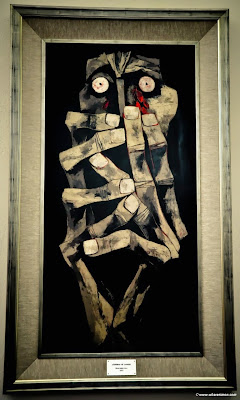Tears Of Blood
>
I didn't know when I would be able to write about this. It feels too raw in my system right now-- raw and not fully digested. When the standard Foder/Frommer/Lonely Planet guide books tell you what to do if you only have two days in Quito, they all mention Oswaldo Guayasamín's Capilla del Hombre (Chapel of Man). Maybe it was just the circumstances of the day but it was one of the most spiritually moving museums I've ever visited, beyond even Jesus' reputed birthplace in Bethlehem. A tribute to all the people of Latin America, Guayasamín's incredible art-- reminiscent of Picasso-meets-Bacon-- captures the profoundly tragic struggle of the indigenous people and the Africans kidnapped and enslaved there.
Now that I'm thinking about it though, I realize I really do need to wait at least a few days to be able to fully convey my experience at La Capilla del Hombre and at Guayasamín's home. What's compelling me to even mention it now is that I stood in front of this painting, Tears of Blood: Homage to Salvador Allende, Victor Jara, and Pablo Neruda, dedicated to the memory of 3 heroes of the people, the first two of whom were slain at the behest of my own country by a handpicked fascist dictator, Augusto Pinochet, shedding my own tears. Immediately afterwards I got an e-mail from my old friend Russ Baker about how the U.S. media, particularly the lapdogs at the NY Times, treated the revelations about a CIA campaign of assassination directed at Latin American social democratic political leaders. I urge you to read the whole article by Dave Lindorff at WhoWhatWhy.
The purportedly “natural”, “accidental”, or “suicide-related” deaths of such important left-leaning figures as Nobel Laureate Pablo Neruda, Brazil’s President Joao Goulart and Chile’s President Salvador Allende all occurred during the rule of various rightist dictators.There was a bunch of Texans on the tour with me, athough they seemed to be on a completely different tour and certainly could never have fathomed in a million years why that painting left me unable to hold back my tears.
The re-examination of evidence in these cases is based therefore on strong skepticism about the “official” narratives of their deaths. This skepticism, in turn, is based on a well-documented history of thousands of cases of political murder in the region.
Investigators from Brazil’s Truth Commission, looking into the 1976 car crash of former leftist Brazilian president Juscelino Kubitschek and his limo driver, have discovered a bullet fragment lodged in the driver’s skull. This finding, the Commission ruled, along with other evidence, suggests that Kubitschek was murdered-- most likely at the behest of the leaders of the CIA-backed military coup that also ousted his successor Joao Goulart.
...The Agency, while perhaps not directing the killings—and which in any case has a history of carefully avoiding a direct evidentiary trail of involvement in covert operations—did enable the building of a crucial database on leftist activists and ousted leaders, and facilitated radio communications among the various countries’ intelligence services.
...That distinction may not mollify Latin Americans who are looking for the truth about the real roots of democracy’s historic collapse in their countries in the 1970s and 1980s.
Additional untimely deaths in Latin America are likely to be reclassified as political murders in the coming months.
While autopsies are not always definitive, forensic studies are becoming more sophisticated. They’re also becoming more popular in a region where the political pendulum has decisively swung in recent years from right to left, with more left-leaning governments being elected in the region-- including in Brazil, Uruguay, Bolivia, Ecuador, Peru, Venezuela, and most recently Chile, where Socialist Michelle Bachelet won a landslide victory in regaining the presidency there.
Those leaders, for obvious reasons, will wants answers to the grim fate of similar leaders who came before them. Currently, for example, the Argentine Forensic Anthropology Team is working to identify victims of that country’s “dirty war” against leftists.
One case to watch carefully is that of Brazilian President Goulart, whose body was exhumed last month. Goulart, who died in exile in Argentina nine months after a junta overthrew his elected government, was officially reported to have suffered a heart attack. But as his death came at the height of Operation Condor, with dictators aiding each other in eliminating their exiled opponents, there has always been speculation that Goulart had actually been murdered.
A former Uruguayan intelligence officer, himself in trouble on other charges, publicly testified a few years back that Goulart was poisoned by Uruguayan operatives at the request of the Brazilian junta. Tissue samples are being sent to Europe for testing.
Labels: Brazil, CIA, Ecuador, Oswaldo Guayasamín




0 Comments:
Post a Comment
<< Home